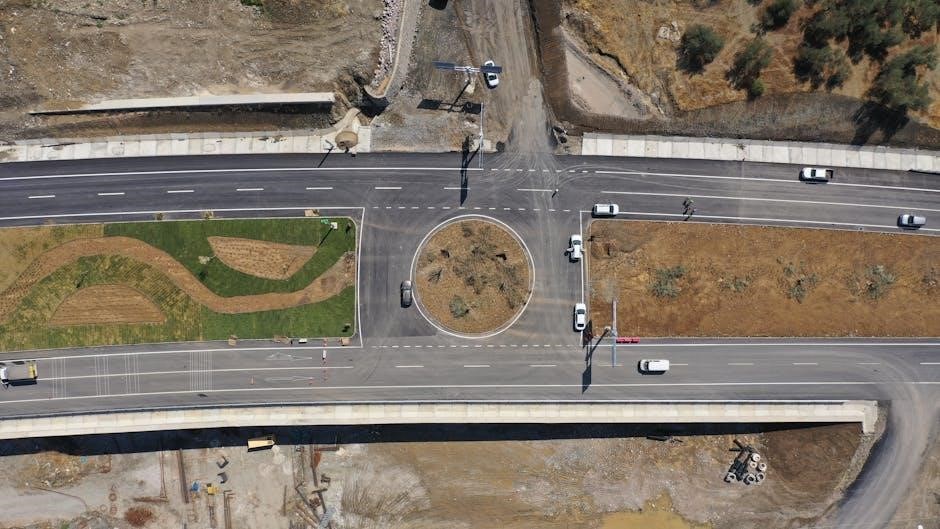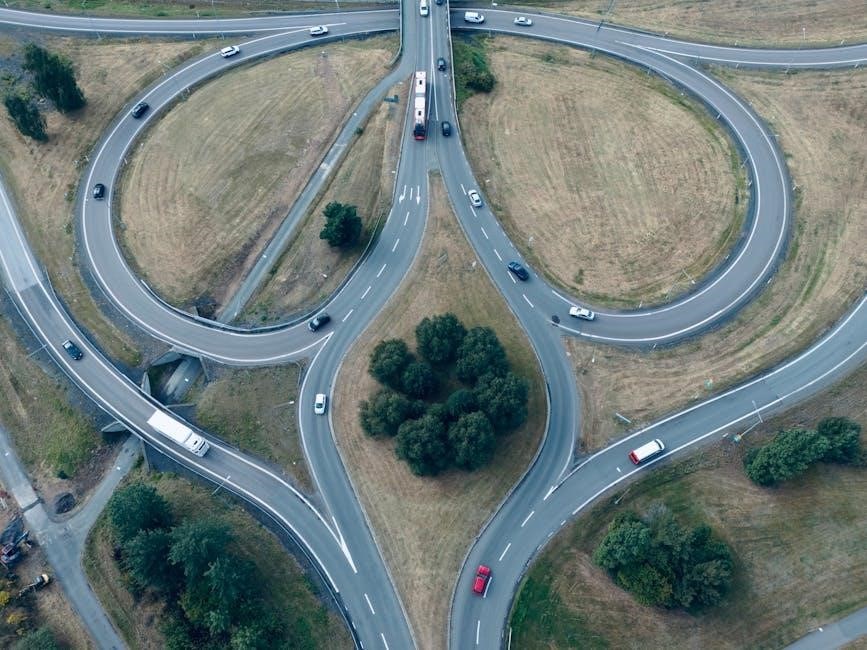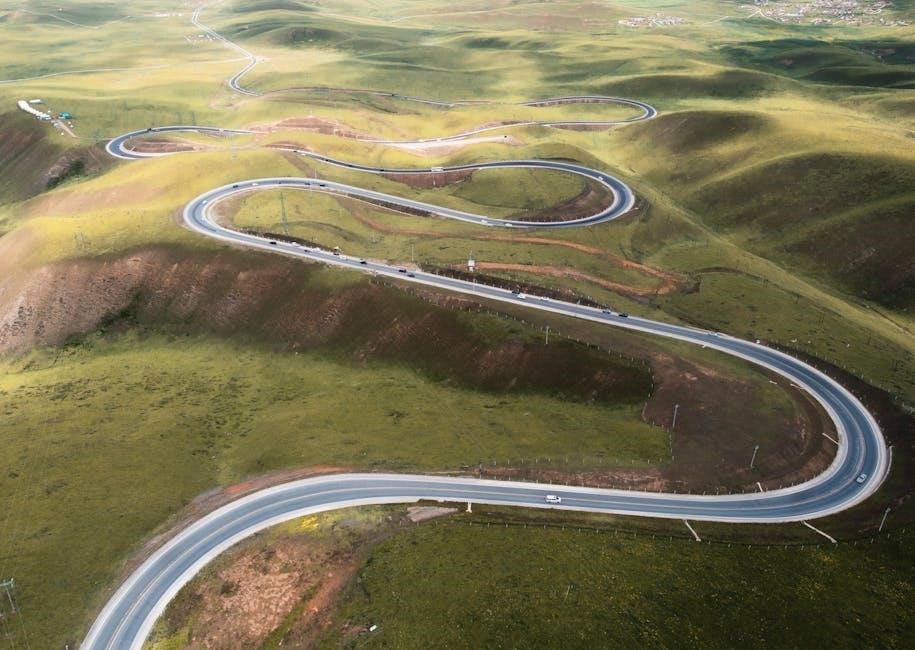sask highway weights map pdf
Category : Canada
The Saskatchewan Highway Weight Map PDF is a comprehensive guide detailing weight classifications and restrictions for provincial highways․ It aids in planning efficient and legal transportation routes․
Overview of the Saskatchewan Highway Weight Classification System
The Saskatchewan Highway Weight Classification System categorizes roads into Primary Weight Highways, 63,500 kg Weight Highways, 9-Month Primary Weight Highways, and Secondary Weight Highways․ Each classification has specific weight limits to ensure safe and efficient transportation while protecting infrastructure․ The system balances economic transport needs with road preservation․ It includes rules like the 15 km restriction, limiting weights beyond certain points․ This classification aids in route planning, compliance, and minimizing road damage․ Regular updates reflect seasonal changes and maintenance, ensuring the system remains effective and adaptable to Saskatchewan’s transportation demands․
Importance of Understanding Weight Limits on Saskatchewan Highways
Understanding weight limits on Saskatchewan highways is crucial for preserving road infrastructure, ensuring public safety, and promoting environmentally responsible transportation․ Exceeding these limits can damage roads, leading to costly repairs and potential closures; Compliance with weight restrictions helps prevent accidents and reduces wear on bridges and pavements․ It also minimizes environmental impacts by avoiding overuse of resources for maintenance․ Knowing these limits enables efficient route planning, avoids penalties, and supports the smooth flow of goods and services across the province․ This knowledge is essential for both commercial and recreational travelers․
Different Types of Weight Classifications
The Saskatchewan Highway Weight Map categorizes roads into Primary Weight Highways, 63,500 kg Weight Highways, 9-Month Primary Weight Highways, and Secondary Weight Highways for efficient routing․
Primary Weight Highways
Primary Weight Highways in Saskatchewan are designated for heavy truck traffic, allowing a maximum gross vehicle weight (GVW) of 62,500 kg․ These highways are strategically designed to accommodate large commercial vehicles, ensuring efficient transportation of goods․ They are typically paved and maintained to withstand heavy loads, making them essential for industries relying on long-haul trucking․ Primary Weight Highways cover most major routes across the province, providing a reliable network for logistics and trade․ They are clearly marked on the weight map, helping drivers plan routes while adhering to weight restrictions․ This classification ensures safe and efficient movement of goods․

63,500 kg Weight Highways
The 63,500 kg Weight Highways in Saskatchewan are designated for vehicles with a maximum gross weight of 63,500 kg, though the actual limit is capped at 62,500 kg․ These highways are part of the province’s weight classification system, ensuring heavy-duty transportation can occur safely and efficiently․ They are identified on the weight map and are crucial for industries requiring higher weight capacities․ This classification balances economic needs with infrastructure preservation, helping to prevent excessive wear on roads․ The 63,500 kg Weight Highways are a key component of Saskatchewan’s transportation network, supporting both regional and national trade logistics․
9-Month Primary Weight Highways
The 9-Month Primary Weight Highways in Saskatchewan are designated for vehicles with a maximum gross weight of 62,500 kg during the designated nine-month period․ These highways are typically closed or restricted during the remaining three months to protect the road infrastructure from damage caused by spring thaw and heavy loads․ This seasonal classification ensures that primary routes remain durable while accommodating the needs of commercial and agricultural transportation․ The 9-Month Primary Weight Highways are clearly marked on the Saskatchewan Highway Weight Map PDF, providing clarity for planners and drivers to navigate efficiently․
Secondary Weight Highways
Secondary Weight Highways in Saskatchewan are designed for lower weight capacities compared to primary highways․ These routes typically have restricted weight limits, often catering to regional traffic and local access․ They are crucial for connecting rural areas and supporting agricultural activities but may not withstand heavy commercial loads year-round; Seasonal restrictions are common to preserve the infrastructure․ The Saskatchewan Highway Weight Map PDF highlights these routes, helping users identify appropriate paths for lighter vehicles while ensuring compliance with weight regulations to maintain road integrity and safety․

Accessing the Saskatchewan Highway Weight Map PDF
The Saskatchewan Highway Weight Map PDF is available for download from the official Government of Saskatchewan website․ It provides an interactive guide to weight classifications․
Downloading the PDF from Official Sources
The Saskatchewan Highway Weight Map PDF can be downloaded directly from the official Government of Saskatchewan website․ This ensures access to the most up-to-date and accurate information․ The PDF is regularly updated to reflect changes in weight classifications, seasonal restrictions, and highway maintenance․ It includes detailed maps, legends, and explanations of weight limits for different highway types․ Users can easily navigate the document to find specific routes or restrictions, making it an essential tool for truckers, logistics planners, and anyone transporting goods in Saskatchewan․
This resource is freely available to the public, promoting transparency and compliance with provincial transportation regulations․
Understanding the Map Legend and Symbols
The map legend is crucial for interpreting the Saskatchewan Highway Weight Map PDF․ It explains the symbols and colors used to denote different weight classifications, such as primary weight highways, 63,500 kg weight highways, and secondary weight highways․ Symbols also indicate restricted areas, bridges with specific weight limits, and seasonal road restrictions․ The legend clarifies the 15 km rule and its implications for routing․ By understanding these elements, users can accurately interpret the map and ensure compliance with weight limits․ The color-coded system helps in quickly identifying routes suitable for specific vehicle weights․
Navigating the Interactive Weight Classification Map
The interactive weight classification map offers a dynamic way to explore Saskatchewan’s highway weight limits․ Users can zoom in/out, filter by weight classes, and search specific routes․ The map displays primary weight highways, 63,500 kg weight highways, and secondary weight highways with clear visual distinctions․ It also highlights restricted areas, bridges, and seasonal road bans․ Real-time updates ensure accuracy, while interactive tools like route planning assist in optimizing trips․ This feature is particularly useful for truckers and logistics planners to ensure compliance with weight regulations and avoid restricted zones efficiently․
Seasonal Road Restrictions and Weight Allowances
Saskatchewan’s seasonal road restrictions adapt to protect infrastructure and ensure safe transportation during changing conditions, with specific weight allowances for winter and summer months․
Winter Weight Allowances on Saskatchewan Highways
During winter, Saskatchewan implements temporary weight allowances to accommodate seasonal transportation needs while protecting roads․ These allowances enable heavier loads under specific conditions but remain lower than summer limits to prevent damage․ The 63,500 kg weight highways often have reduced restrictions during winter, while primary highways maintain stricter limits․ Temporary road bans may be lifted during cold snaps to assist farmers and shippers, ensuring economic activities continue uninterrupted; Understanding these seasonal adjustments is crucial for compliant and efficient transportation planning in Saskatchewan․
Summer Weight Restrictions and Regulations
During the summer months, Saskatchewan enforces strict weight restrictions to prevent damage to roads․ Primary weight highways have lower limits compared to winter, while secondary highways face tighter regulations․ Temporary road bans are often implemented to protect deteriorating road surfaces․ Shippers and carriers must adhere to these summer weight restrictions to avoid penalties․ The Saskatchewan Highway Weight Map PDF provides detailed insights into these regulations, ensuring compliance and minimizing infrastructure damage․ Understanding these seasonal limits is essential for safe and efficient transportation planning during warmer months․

Temporary Road Bans and Permits
Temporary road bans are implemented in Saskatchewan to protect roads during seasonal thaw or construction․ These bans restrict certain vehicle weights on specific highways, requiring special permits for exceptions․ The Saskatchewan Highway Weight Map PDF highlights areas under temporary restrictions, helping carriers plan routes․ Permits ensure compliance with weight limits, preventing infrastructure damage․ Failure to adhere to these bans can result in fines․ Staying informed through the PDF and official updates is crucial for avoiding penalties and maintaining smooth transportation operations during restricted periods․
Bridge and Highway Restrictions
The Saskatchewan Highway Weight Map PDF outlines specific weight limits for bridges and highways to prevent structural damage․ It helps users plan routes while adhering to restrictions․
Bridge Weight Limits and Restrictions
The Saskatchewan Highway Weight Map PDF provides detailed information on bridge weight limits and restrictions across the province․ These restrictions are implemented to protect bridges from structural damage caused by excessive weight․ The map outlines specific weight allowances for bridges, ensuring safe and legal transportation of goods․ By adhering to these limits, carriers can avoid potential damage to infrastructure and related penalties․ The document is essential for planning routes that comply with bridge weight regulations, thereby maintaining the integrity of Saskatchewan’s transportation network and ensuring public safety․
Highway Classification and Weight Limits
The Saskatchewan Highway Weight Map PDF categorizes highways into distinct classes with specific weight limits․ Primary weight highways allow a maximum of 62,500 kg, while 63,500 kg weight highways are designated for heavier loads․ Secondary weight highways have more restrictive limits, ensuring safe and controlled access․ The classification system helps preserve infrastructure by distributing weight evenly and preventing damage․ By adhering to these limits, carriers ensure compliance with provincial regulations and maintain the structural integrity of Saskatchewan’s road network․ This system is vital for efficient and lawful transportation across the province․
The 15 km Rule and Its Implications
The 15 km rule in Saskatchewan applies to vehicles exceeding 62,500 kg on Primary and 63,500 kg weight highways․ It restricts travel beyond 15 km on these routes without a permit, ensuring infrastructure protection․ This regulation prevents overloading, which can damage roads and bridges․ Compliance is critical to avoid penalties and maintain safe transportation standards․ The rule underscores the importance of adhering to weight limits for sustainable road maintenance and efficient goods movement across the province․ It balances economic needs with infrastructure preservation, ensuring long-term viability of Saskatchewan’s highway network․

Max Weight Limits on Saskatchewan Highways
The maximum weight limits on Saskatchewan highways vary by classification․ Primary weight highways allow up to 62,500 kg, while 63,500 kg weight highways permit slightly higher loads․

Primary Weight Highways ౼ Maximum 62,500 kg
Primary weight highways in Saskatchewan are designated for heavy truck traffic, with a maximum gross vehicle weight (GVW) of 62,500 kg․ These routes are critical for commercial transportation, ensuring efficient movement of goods while protecting infrastructure․ The 15 km rule applies to these highways, allowing access to secondary roads for local deliveries․ Drivers must adhere to these limits to avoid damage to roads and bridges․ The Saskatchewan Highway Weight Map PDF provides detailed routing information, helping operators plan compliant and efficient trips across the province․
63,500 kg Weight Highways ౼ Max Weight is 62,500 kg
The 63,500 kg Weight Highways in Saskatchewan are designed to accommodate heavy-duty transport, but the maximum allowable weight is capped at 62,500 kg․ This classification ensures that roads can handle heavy traffic without sustaining damage․ These highways are part of the province’s weight management system, balancing economic needs with infrastructure preservation․ Seasonal variations may apply, particularly in winter, when weight restrictions are often relaxed to support industries like agriculture․ Compliance with these limits is crucial to maintain road integrity and ensure safe transportation across Saskatchewan․ The Highway Weight Map PDF provides detailed routing for these corridors․
Secondary Weight Highways ౼ Restricted Weights
Secondary weight highways in Saskatchewan are subject to stricter weight restrictions compared to primary weight highways․ These routes are designed for lighter traffic and are more prone to damage from excessive loads․ The maximum allowable weight on these highways is significantly lower, typically catering to smaller commercial vehicles and local traffic․ Seasonal variations may further reduce weight limits to protect the road surface during vulnerable conditions․ Adhering to these restrictions is essential to maintain infrastructure integrity and ensure public safety․ The Highway Weight Map PDF provides clear markings for these routes, helping drivers plan accordingly and avoid penalties․

Why Weight Restrictions are Necessary
Weight restrictions are essential to protect road infrastructure from damage caused by heavy loads and ensure safe transportation for all users․ They also help reduce maintenance costs and prevent environmental impacts․
Preserving Road Infrastructure
Weight restrictions on Saskatchewan highways are crucial for maintaining road integrity․ Heavy vehicles can cause significant damage to road surfaces, leading to costly repairs and frequent maintenance․ By adhering to weight limits, the lifespan of roads is extended․ The Saskatchewan Highway Weight Map PDF classifies roads into primary and secondary weight highways, ensuring only appropriate vehicles use them․ Seasonal restrictions further protect roads during vulnerable conditions, such as winter freeze-thaw cycles․ This proactive approach prevents deterioration, reduces maintenance needs, and ensures roads remain safe and functional for all users․ Proper weight management is essential for long-term infrastructure preservation․
Ensuring Safe Transportation

The Saskatchewan Highway Weight Map PDF plays a vital role in promoting road safety by regulating vehicle weights․ Exceeding weight limits can lead to accidents and infrastructure damage․ By adhering to these restrictions, drivers ensure safer travel conditions for all road users․ Weight classifications help prevent overloading, which can cause mechanical failures or loss of control․ Additionally, the map highlights restricted areas and bridges, guiding drivers to safer routes․ This system minimizes risks associated with heavy vehicles, fostering a safer transportation environment while protecting both passengers and infrastructure; Safe weight compliance is essential for accident prevention and highway stability․
Environmental Considerations
The Saskatchewan Highway Weight Map PDF aids in minimizing environmental impact by preventing overloading, which can damage roads and surrounding ecosystems․ Excessive weight on highways can lead to increased fuel consumption, higher emissions, and greater wear on infrastructure, all of which contribute to environmental degradation; By adhering to weight restrictions, drivers help reduce the need for frequent repairs and construction, lowering the overall environmental footprint of transportation․ This promotes sustainable road use and protects natural habitats adjacent to highways․ Environmental preservation is a key benefit of following the weight classifications outlined in the map․
Reading and Interpreting the Weight Map
The Saskatchewan Highway Weight Map PDF includes detailed legends and symbols to help users interpret weight classifications and restrictions for efficient and safe transportation planning․
Understanding Weight Classification Legends
The weight classification legends on the Saskatchewan Highway Weight Map PDF explain the symbols and colors used to denote different weight limits and highway classifications․ These legends help users identify primary weight highways, 63,500 kg weight highways, and secondary weight highways․ They also clarify restrictions, such as winter weight allowances and bridge weight limits․ By understanding these legends, drivers and planners can interpret the map accurately, ensuring compliance with regulations and safe transportation․ The legends are essential for navigating the highway weight map effectively and avoiding potential fines or damages․
Identifying Primary and Secondary Weight Highways
The Saskatchewan Highway Weight Map PDF clearly distinguishes between primary and secondary weight highways using distinct colors and symbols․ Primary weight highways, marked prominently, allow the highest weight limits, typically up to 62,500 kg, and are designed for heavy commercial traffic․ Secondary weight highways, shown with different markings, have lower weight restrictions and are suitable for lighter loads․ Understanding these classifications is crucial for route planning, ensuring compliance with weight regulations, and avoiding penalties․ The map’s legend provides detailed guidance on identifying these highways efficiently․
Recognizing Restricted Areas and Bridges
The Saskatchewan Highway Weight Map PDF highlights restricted areas and bridges with specific symbols and markings․ Restricted areas, often marked in red or orange, indicate roads where weight limits are strictly enforced or where temporary bans are in place․ Bridges are similarly identified, with their weight limits clearly noted to prevent overloading․ These designations are critical for ensuring safe passage and avoiding potential damage to infrastructure․ Drivers must pay close attention to these markings to comply with regulations and avoid penalties․ The map legend provides detailed explanations of these symbols for easy interpretation․

Compliance and Enforcement
Compliance with weight restrictions is crucial for maintaining road safety and infrastructure integrity․ Enforcement measures ensure adherence to regulations, while penalties address violations, promoting responsible transportation practices․
Importance of Adhering to Weight Limits
Adhering to weight limits on Saskatchewan highways is essential for preserving road infrastructure, ensuring public safety, and avoiding legal penalties․ Exceeding these limits can cause significant damage to roads and bridges, leading to costly repairs and potential hazards for all road users․ Compliance helps maintain the structural integrity of highways and prevents unnecessary wear and tear․ Additionally, following weight restrictions ensures efficient and safe transportation, reducing the risk of accidents caused by overloaded vehicles․ Using the Saskatchewan Highway Weight Map PDF is a crucial step in planning routes that comply with these regulations, promoting responsible and lawful transportation practices across the province․
Consequences of Overweight Violations
Violating weight limits on Saskatchewan highways can result in severe penalties, including hefty fines and legal actions․ Overweight vehicles may be stopped and forced to offload excess cargo, causing delays and additional costs․ Repeated violations can lead to suspended permits or even legal prosecution․ Moreover, exceeding weight restrictions can damage road infrastructure, accelerating wear and tear on highways and bridges․ Non-compliance jeopardizes public safety and increases maintenance expenses for the province․ Using the Saskatchewan Highway Weight Map PDF helps avoid these consequences by ensuring adherence to regulations and planning compliant routes․
Permits and Exceptions
In Saskatchewan, certain overweight vehicles may be granted special permits to operate on restricted highways․ These permits are typically issued for specific routes and time periods, ensuring minimal impact on infrastructure․ Exceptions may apply for vehicles transporting essential goods or in emergency situations․ The 15 km rule allows heavyweight vehicles to travel on non-primary highways within 15 km of their destination․ Operators must consult the Saskatchewan Highway Weight Map PDF to identify permissible routes and apply for necessary permits through official channels to avoid violations and ensure compliance with regulations․

Highway Maintenance and Upgrades
The Saskatchewan Highway Weight Map PDF highlights how weight restrictions help preserve road infrastructure․ Ongoing upgrade projects, like Highway 368, enhance safety and efficiency for all users․
Impact of Weight Restrictions on Road Maintenance
Weight restrictions play a critical role in preserving Saskatchewan’s road infrastructure․ By limiting heavy vehicle loads, these restrictions prevent damage to pavement and road beds, reducing maintenance costs․ Primary weight highways can handle heavier loads year-round, while secondary roads have lower limits to avoid deterioration․ Seasonal weight adjustments, such as winter weight allowances, further protect roads during vulnerable periods․ This balanced approach ensures roads remain durable and safe for all users, supporting both economic activities and public safety․ Proper enforcement of these restrictions is essential for long-term infrastructure sustainability․
Upgrading Projects on Saskatchewan Highways
Saskatchewan is actively investing in highway upgrading projects to enhance road infrastructure and support economic growth․ For instance, multi-year projects like the upgrading of Highway 368 are underway, with significant funding allocated to improve safety and efficiency․ These upgrades aim to accommodate increasing traffic and heavier loads, ensuring compliance with weight classifications․ By modernizing highways, the province seeks to reduce maintenance needs and provide reliable routes for commercial and residential users․ Such projects are part of a broader strategy to strengthen the transportation network and promote sustainable development across Saskatchewan․
Future Plans for Highway Expansion
Saskatchewan plans to expand its highway network to accommodate growing transportation demands․ Over 1,190 kilometres of roads have been added to the primary weight highway system, enhancing route options for shippers and carriers․ Future expansions aim to improve connectivity and reduce travel times, particularly for commercial trucking․ These plans align with economic growth strategies, ensuring efficient goods movement while maintaining infrastructure integrity․ Upcoming projects focus on upgrading key corridors to handle increased traffic and heavier loads, supporting both industrial and residential needs across the province․
The Saskatchewan Highway Weight Map PDF is an essential tool for planning routes, ensuring compliance with regulations, and preserving infrastructure․ It supports safe, efficient, and environmentally friendly transportation․
The Saskatchewan Highway Weight Map PDF provides a detailed overview of weight classifications and restrictions, aiding in efficient route planning and legal compliance․ It ensures safe transportation and preserves road infrastructure by outlining specific weight limits․ The map categorizes highways into primary, 63,500 kg, and secondary weight classifications, each with distinct restrictions․ It includes a legend for symbols and offers an interactive version for easier navigation․ This resource is essential for trucking, logistics, and maintaining compliance with provincial transportation regulations․
Encouragement to Use the Saskatchewan Highway Weight Map PDF
The Saskatchewan Highway Weight Map PDF is an indispensable tool for ensuring compliance with provincial weight regulations․ By using this resource, truckers, logistics planners, and transport companies can efficiently plan routes, avoid restricted areas, and prevent potential fines․ It promotes safe and sustainable transportation while protecting Saskatchewan’s infrastructure․ The map’s detailed legends and classifications make it user-friendly, ensuring adherence to weight limits and seasonal restrictions․ Encouraging its use is vital for maintaining efficient and lawful transportation practices across the province․ Download and utilize this essential guide for seamless navigation and compliance․






























